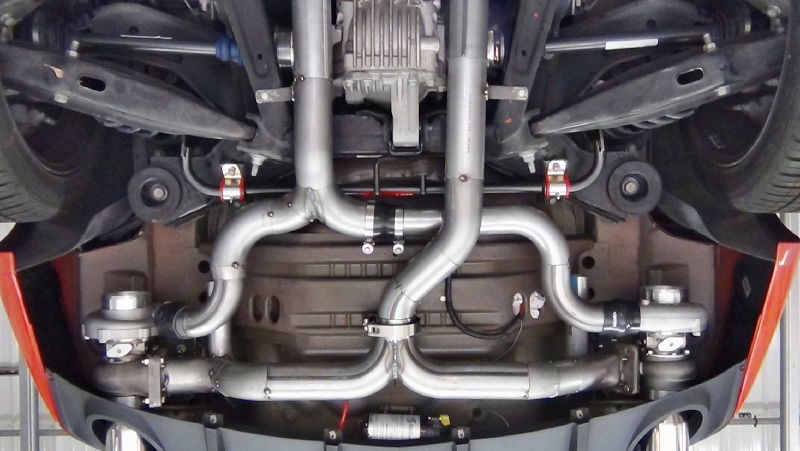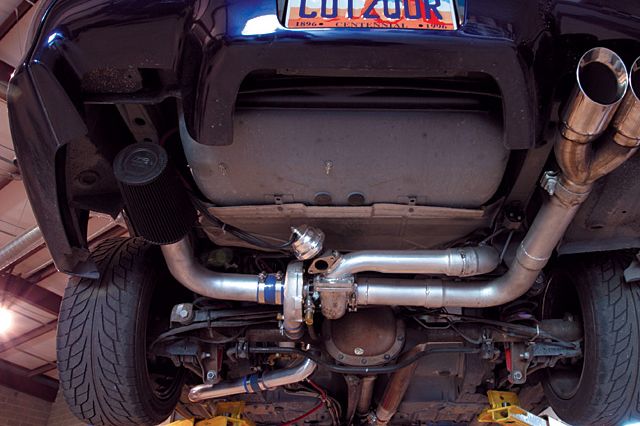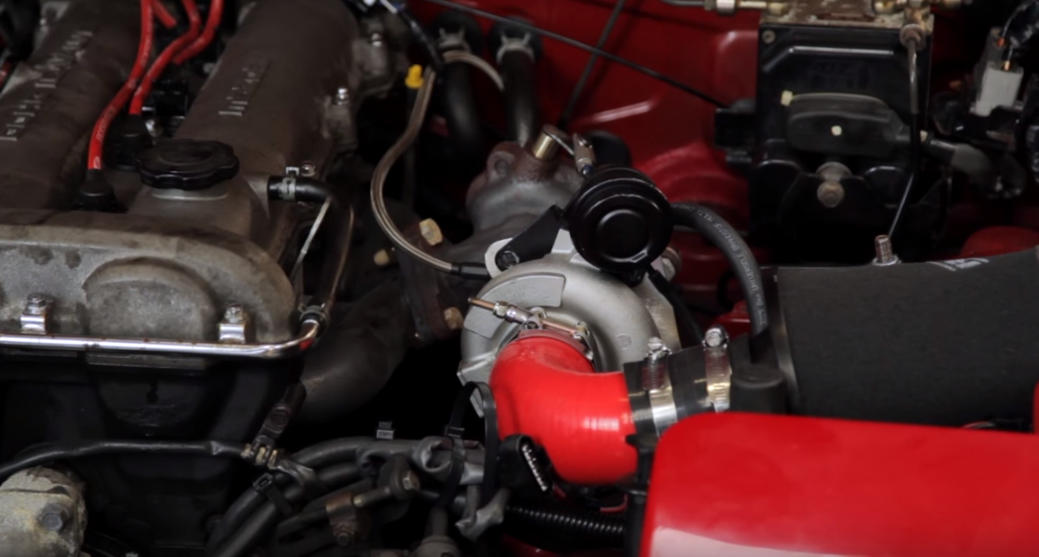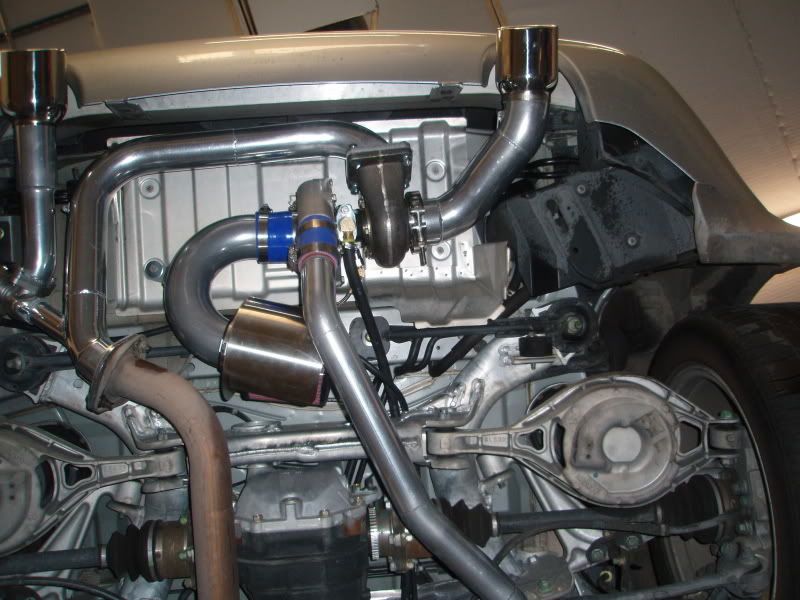What's Good And Bad About Rear-Mounted Turbochargers

Turbocharger placement - it’s an age old problem in the business of modifying car. Engine compartments can be cramped places, so fitting in one or more snails and all the associated parts isn’t easy.
An alternative placement for a turbocharger is to have it rear-mounted as part of the exhaust system, replacing the silencer/backbox with the turbine and multiple routes of additional tubing. Although these systems may look fairly impressive and offer what may seem like a bunch of advantages to a standard turbocharged system, is a rear-mounted turbo a genuine option?
Advantages
Seeing as the turbocharger increases the energy of the air by compressing it, the air exits the turbine in an extremely hot state which is normally where an intercooler comes in. Engines prefer colder, denser air to compress within the cylinders so intercooler are then used to cool the intake air to the engine from a turbo system. Having a turbo rear-mounted means that as the charge air from the turbocharger travels back to the engine, it is simultaneously cooled by the ambient air running underneath the car, saving the need for an intercooler.
The increased cooling effects also helps oil cooling, a very important aspect of reliable turbocharging. The oil circulating around the turbine is used for both the lubrication and cooling of the system - a lack of fluid can spell disaster for the turbocharger. The vast flow of cold air under the car will therefore help in keeping the oil cool and keeping the turbocharger operating smoothly.
It is estimated that a rear-mounted turbocharger will produce 260 degrees centigrade less heat build up than a front-mounted unit nestled in an engine bay. The huge amount of heat generated by a turbocharger can have an influence on other components nearby that don’t deal well with heat, like the engine block and engine cooling system, so rear-mounting takes away any possible effects of heat soak from a turbocharger to unwanted areas.
Disadvantages

Although all of those points seem to make a whole lot of sense, things aren’t all hunky-dory. First of all, there’s the sheer amount of tubing that has to be placed below the car to integrate the turbo. All of that compressed air from the turbo has to get back to the engine to be forced back into the cylinders, so intricate piping has to be put in place to achieve this.
This is also applicable for the oil system which will need a long feed from the sump to function properly, or a bespoke oil reservoir put in place to cope with the demands of the hot turbocharger.
Also, if all this tubing isn’t designed properly - with the right increases and decreases in diameter (especially to match the turbocharger inlet) - turbo lag will become a serious issue. With the turbocharger not being situated in close proximity to the inlet manifold, natural lag will be present as the compressed air has to travel further to reach the engine’s cylinders. Although this can be combated with a finely-tuned tubing system, most bolt-on kits will probably not be 100 per cent suited to your car’s powertrain.

Turbocharger efficiency can take a bit of a hit when compared to a standard engine bay placement or a hot-V setup. The intake air to the turbocharger will have cooled by the time it reaches the area once filled by the backbox as it travels down the exhaust system. As stated before, the turbocharger prefers nice hot air to function to its maximum capabilities, meaning that this natural cooling will reduce the turbine’s efficiency.
A turbocharger also thrives when large pulses of exhaust gases are sent through its inlet, but unfortunately these pulses will have decreased in size by the time they reach a rear-mounted system. This lack of pre-existing kinetic energy within the exhaust gas flow will further stump the turbocharger’s efficiency.

Forums are littered with arguments over rear-mounted turbo systems and whether they’re worth it, and in most cases the general rule is that they are not worth the hassle. The sheer amount of intricate plumbing needed to keep the system functioning properly is a hellish project to undertake and many of the cooling benefits are vastly outweighed by the lack of heat that a rear-mounted turbo would suffer from.
They may look dank, but I’d personally keep to the traditional engine bay cram, mostly because you don’t want that wonderful choo-choo to be wasted on everyone behind you!
Comment below with your thoughts on a rear-mounted setup, or if you already have one!
Comments
It’s only worth it if you have a rear engined car like a 911. Just check out bisimoto’s Porsches. hell, it could even work on mid-engine setups like the underground racing boosted lambos and their other crazy rides. It’s a bit silly for a front engined setup tho.
also the extra weight of all that tubing to the rear, front mounted just makes so much more sense imo
I’m always game for a laugh and have mates who will help out when needed.
I have a Land Rover Defender and I’m contemplating moving the exhaust to exit the car right behind the cab(it’s a pickup).
When I read about a rear mounted turbo I got to wondering if it would be a good idea to rear mount my turbo behind the cab too?
Or…separate the outside two exhaust outlets from the inner two and pipe each pair into a smaller turbos.
Would I have invented a hybrid twin turbo2scroll thingumajig?
Or would I have invented a crock?
its been proven time and time again that the best way to reduce lag is to either mount the turbo to a very short exhaust manifold or to place it right where the exhaust gasses have their max expansion due to the continued burn past the combustion chamber…. usually 16 to 20 inches from the cylinder head. Gas density and velocity is greatly reduced by the time it reaches the back of the vehicle. Yes these systems work but why not get the best bang for your buck and do it right. also notice no legit races cars us this system.
t
By the way… centigrade is not an actual temperature measurement. The correct term is Celsius. Sorta like how kilometres are labeled as kph. Kilos per hour are used by drug lords. It should be km/h.Same error with the mysterious creation of the ‘centigrade’ scale. ‘Centi’ merely means 100 so is not and cannot be a measurement.
Go through a deep puddle and your intake goes under water. Best fit twin snorkels out the rear or put the intake in body gills in the back. This would look cool!
Anyone care to know that exhaust pulsing and heat is the enemy of a turbocharger, not its friend, and what is actually required to run a turbo is a large volume of cool constant air pressure, which in most part is found at the rear of the car, the problem is as the exhaust gas cools it shrinks, thus reducing the effective volume of air available to run the turbo. Michael Fernie either dose not understand how a turbo or car engine works or has made some very poor word choices in this article.
Pagination